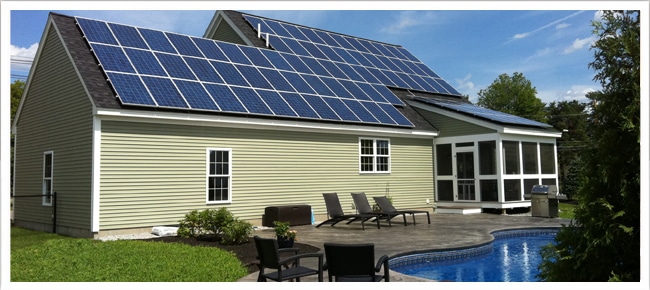Positive Energy Homes are Zero Energy Homes that are so efficient that the homes produce more energy than they consume. They are the gold standard for green homes. A home can be designed and built as a Positive Energy Home from the start, or homeowners can gradually transform their Zero Energy Home into a Positive Energy Home. The excess energy produced can, in some states, be sold back to the grid, or it can be used to power solar vehicles, lawn and yard equipment or power tools, or a sauna.
Paths to a Positive Energy Home
There are several paths to creating a Positive Energy Home.
- During the design stage, after a highly energy efficient home has been designed, oversize the solar collectors so that they produce more energy than the home will consume.
- Start with sufficient solar panels to achieve a Zero Energy Home utilizing micro-inverters. The micro-inverters will allow the system to be easily expanded when you are ready to transform it into a Positive Energy Home.
- Starting with a standard Zero Energy Home, install an energy monitoring system in your home to systematically guide you in reducing your family’s energy consumption and follow the guidelines for zero energy green living as far as possible so that your energy consumption becomes lower than your home’s energy production.
- Continue living in your Zero Energy Home once your children have grown and left home. At that point, your energy consumption will drop, while your Zero Energy Home’s energy production stays constant and the home’s yearly net energy production moves into positive territory.
How to Use Excess Energy Production
In some states and power districts, people can actually sell their excess electricity back to the power company to make a profit and more actively contribute to the reduction in greenhouse gas production. However, in many locations, once you have achieved net zero, you cannot sell your excess production to the electric company. In this case one of the most economically sound ways of utilizing the excess electric production is to power an electric vehicle, so that your Positive Energy Home provides you with Zero Net Energy Transportation. If the excess energy produced is more modest, another option is to power yard machines such as an electric leaf blower, an electric lawnmower, an electric motor bike, or electric power tools so that you no longer need the highly polluting and noisy gas-powered versions. In other words, Positive Energy Homes allow the occupants to take green living to the level we all will need to achieve to stabilize the climate and live comfortably with high priced fossil fuels.
Solar Powered Vehicles
The sun that hits your roof can power your car. And a solar powered electric car can meet most or all of a family’s local, and in some cases, long distance, driving needs. In some communities and family situations, electric bicycles and road-worthy golf cart vehicles can be utilized for a significant portion of local transportation needs. With the kilowatts produced by each 1 kWh solar PV system in northern U.S. you can power an electric car, such as the Nissan Leaf, for an average of 12 miles a day, approximately 4,000 miles a year, which may meet many local transportation needs. With an electric car like the Leaf, depending on driving conditions, you can travel 70 to 80 miles per charge, which could allow for commuting to work and doing all your local travel for free.
A simple rule of thumb for the northern U.S. is that 1 kWh of electricity will power an electric car about 3 miles. A 1 kWh PV system will produce about 4 kWh per day on average, which will power your car for about 12 miles per day. A 2 kWh PV system will produce about 8 kWh per day on average, which will power a car for 24 miles per day. A 3 kWh PV system will power a car for about 36 miles per day, or about 12,000 miles per year. In the southern U.S., photovoltaic systems will produce even more kWh each day powering the car even further. A Positive Energy Home that powers, not only the home, but also an electric car is a green living goal that is increasingly attainable.
Utilizing a positive energy home to power your electric vehicle provides free transportation and frees you from gas price hikes and possible shortages. Most important, it helps you to reduce your overall carbon emissions closer to Zero.
This article originally appeared on ZeroEnergyProject.com. Visit their site to learn more!
ZeroEnergyProject.com is a non-profit educational site designed to help builders, designers, and home buyers take meaningful steps towards radically reducing carbon emissions and energy bills by building Zero Net Energy Homes and Near Zero Energy Homes. We envision the day when Positive Energy Homes, which produce more energy than they consume, power electric vehicles, as well as homes, so that we can live well with less expense and without fear of energy price spikes, while greatly reducing our carbon emissions.



